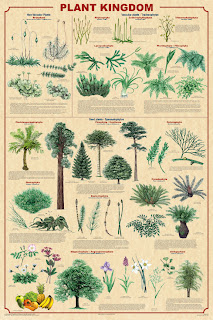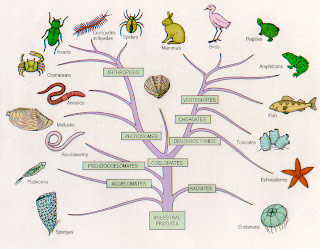Home
Eukaryotes
The organisms whose cells
contain a nucleus. A saclike structure that encloses the cell’s hereditary
materials. The presence of a nucleus distinguishes eukaryotes from prokaryotes,
those simple, one-celled organisms in which the hereditary material floats free
within the cell. Only the eukaryotic cell is capable of a high
degree of specialization, and specialization is what makes multi cellular
organisms possible. Just as banks, post offices, and other specialized workplaces are intrinsic to a city, cells tailored for certain jobs are
intrinsic to more-complex organisms. Working in concert, specialized cells can
create a higher level of organization known as tissues, such as the growing
shoot of a plant or the spiny skin of a sea star. Coordinated tissues form
organs and, in animals, these organs combine to form complex organ systems,
such as the circulatory, digestive, and respiratory systems. The orchestration
of these organ systems makes up the organism.
workplaces are intrinsic to a city, cells tailored for certain jobs are
intrinsic to more-complex organisms. Working in concert, specialized cells can
create a higher level of organization known as tissues, such as the growing
shoot of a plant or the spiny skin of a sea star. Coordinated tissues form
organs and, in animals, these organs combine to form complex organ systems,
such as the circulatory, digestive, and respiratory systems. The orchestration
of these organ systems makes up the organism.
 workplaces are intrinsic to a city, cells tailored for certain jobs are
intrinsic to more-complex organisms. Working in concert, specialized cells can
create a higher level of organization known as tissues, such as the growing
shoot of a plant or the spiny skin of a sea star. Coordinated tissues form
organs and, in animals, these organs combine to form complex organ systems,
such as the circulatory, digestive, and respiratory systems. The orchestration
of these organ systems makes up the organism.
workplaces are intrinsic to a city, cells tailored for certain jobs are
intrinsic to more-complex organisms. Working in concert, specialized cells can
create a higher level of organization known as tissues, such as the growing
shoot of a plant or the spiny skin of a sea star. Coordinated tissues form
organs and, in animals, these organs combine to form complex organ systems,
such as the circulatory, digestive, and respiratory systems. The orchestration
of these organ systems makes up the organism.
Size and Structure of Eukaryotes
 The complexity of eukaryotic
cells is reflected in their size. In general, the diameter of eukaryotic cells,
which range in size from 0.01 mm to 1 mm (0.000394 in to 0.0394 in), is 10 to
100 times that of typical prokaryotic cells. An average-sized animal cell measures
about 0.020 mm (0.0008 in), about one-fifth the thickness of the page of a
book, while a typical plant cell is slightly larger, about 0.035 mm (about
0.0014 in). The eukaryotic cell with the greatest diameter is the ostrich egg,
which measures about 120 mm (4.72 in). The longest eukaryote cells on record
are the nerve cells that extend 3 m (10 ft) down a giraffe’s neck.
The complexity of eukaryotic
cells is reflected in their size. In general, the diameter of eukaryotic cells,
which range in size from 0.01 mm to 1 mm (0.000394 in to 0.0394 in), is 10 to
100 times that of typical prokaryotic cells. An average-sized animal cell measures
about 0.020 mm (0.0008 in), about one-fifth the thickness of the page of a
book, while a typical plant cell is slightly larger, about 0.035 mm (about
0.0014 in). The eukaryotic cell with the greatest diameter is the ostrich egg,
which measures about 120 mm (4.72 in). The longest eukaryote cells on record
are the nerve cells that extend 3 m (10 ft) down a giraffe’s neck.  |
| Ostrich egg |
The largest and most conspicuous
organelle is the nucleus. The nucleus encloses and protects the cell’s genetic
material, deoxyribonucleic acid (DNA), so that it is not damaged by biochemical
reactions in the cell. Within the eukaryotic nucleus, DNA is wrapped around
specialized proteins called histones, like a thread wound around a series of
spools. Each DNA strand and its histones fold back and forth several times to
form a compact, stick-shaped structure called a chromosome. Depending on the
organism, the nucleus contains from one to over a thousand chromosomes.
Surrounding the nucleus is the nuclear envelope, a membrane with numerous
pores. The pores, ringed by special protein, regulate the flow of substances
into and out of the nucleus.
Eukaryotic Nutrition
To function, eukaryotes need organic
molecules: carbohydrates such as sugar and starch; proteins; lipids, which
include fats and oils; and nucleic acids such as DNA. Sugars such as glucose
are particularly important because eukaryotes use energy from sugar to build
proteins, lipids, and other organic molecules. Photosynthetic eukaryotes are
known as autotrophs, a group that includes plants, seaweeds, and microscopic
algae, all of which can make their own sugar. Those that must take in sugar
from outside sources are called heterotrophs. Among the heterotrophs are many
single-celled eukaryotes, and all fungi and animals.
Heterotrophic eukaryotes typically absorb
the nutrients in food through the plasma membrane. To accomplish this task,
they must first break down, or digest, the food. Fungi secrete digestive
enzymes onto the surface of their food—often decaying leaves or branches—and
then absorb the enzyme-released nutrients across the cell wall and plasma
membrane. In contrast, animals first ingest their food into some sort of
digestive structure such as the stomach. There, digestive enzymes break down
the food, and the nutrients are then absorbed into the cells.
Some single-celled eukaryotes, such as
amoebas, use a process called endocytosis. In endocytosis, these organisms
extrude part of the plasma membrane, scoop up a food particle, and drag it into
the cell, where they digest it using enzymes within the cell. In these
eukaryotes, large waste molecules typically are expelled from the cell by a
reverse process called exocytosis. The waste is bundled into a sac called a
vesicle and transported to the plasma membrane, where it fuses with the
membrane. The waste is then expelled through a hole in the fused membrane. In
complex animals, cells generate wastes such as urea when nutrients are broken
down within cells. These wastes are transported by blood to the kidneys. The
kidneys process the waste and produce urine, which is removed from the body
through the bladder. Undigested food travels through the tube like intestines
and is eliminated through the digestive system.
Cell Division
Eukaryotes carry out cell
division to make the new cells needed for growth, to repair damaged cells, and
to replace worn out, dying cells. Most eukaryotic cells divide by mitosis,
a process that produces two cells with the same genetic information as the
original cell. Single-celled eukaryotes, such as amoebas and diatoms, commonly
reproduce by mitosis.
 Many eukaryotes also undergo
a second type of cell division, called meiosis, which is designed for sexual
reproduction, the union of male and female sex cells. In meiosis, two cell
divisions occur in which the genetic material is rearranged, resulting in four
genetically unique cells, each of which contains only half the number of
chromosomes as the parent cell. When two cells with half the number of
chromosomes unite, the new cell contains the full complement of chromosomes
needed to produce the new organism.
Many eukaryotes also undergo
a second type of cell division, called meiosis, which is designed for sexual
reproduction, the union of male and female sex cells. In meiosis, two cell
divisions occur in which the genetic material is rearranged, resulting in four
genetically unique cells, each of which contains only half the number of
chromosomes as the parent cell. When two cells with half the number of
chromosomes unite, the new cell contains the full complement of chromosomes
needed to produce the new organism.
Evolutionary Origin of Eukaryotic
Eukaryotes evolved much later than
prokaryotes, whose origins date to about 3.5 billion to 3.8 billion years
before present. Alga-like fossils from ancient rocks suggest that eukaryotes
may have evolved about 2.1 billion years before present. Other fossil remains
indicate that eukaryotes were well established 1.6 billion years before
present. These fossils, called acritarchs, are hollow spheres that appear to be
spores or cysts of eukaryotic algae.
Eukaryotic cells are thought to
have evolved from primitive prokaryotes. Evidence for this view is found in the
archaea, prokaryotes that resemble both bacteria and eukaryotes. Like bacteria,
the archaea lack a nucleus and most other organelles. Like eukaryotes, they
display flexible cell membranes and histone proteins, and have certain segments
of DNA in common. This evidence, along with other molecular studies, leads many
scientists to conclude that archaea, bacteria, and eukaryotes arose from a
common ancestral prokaryote similar to the archaea. However, according to a
theory developed by American microbiologist Carl Woese, the archaea, bacteria,
and eukaryotes may have arisen, not from a single common ancestor, but from a group
of genetically diverse, primitive prokaryotes.











